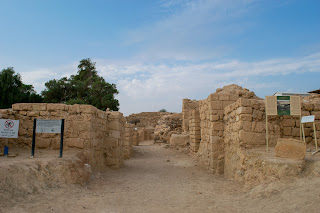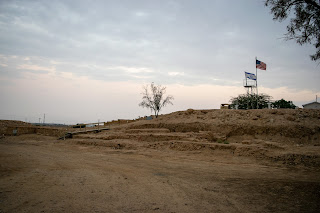It's not everyday you wake up next to a fortress dating back to the time of Solomon. Needless to say, those are the days (my) dreams of made of!
But that's exactly what happened to me the weekend of Hanukah and Christmas 2022. Some friends and I were able to stay at Tamar Park, near the spring of Hazeva in the Arabah Valley of the Wilderness of Zin (part of where the Israelites wandered for 40 years).
Wow!

Being so near a spring, the location of biblical Tamara was significant, because it sat at the crossroads of ancient routes... meaning it would have been a stopping point for travelers. The archeological remains date back to the Israelite Kingdom, Nabatean, Roman, and Byzantine empires!
In 10th century B.C., the time of Solomon, this route was used to trade with Arabia, Africa, and Sheba, as is described in 1 Kings 10. Tamar is mentioned as "Tadmor" in 1 Kings 17-18. In addition to the spring, it also lay near a copper mine, which was a major trading commodity for both Kings David and Solomon. It's believed that this is why David conquered Edom in 1 Chronicles 18. Edom, which we'll talk about in a future post, is an area of the desert where the land is red. It was the ancient land of Esau. (Something that makes me wonder: it's interesting to me that the area is red, and there was copper nearby. Is there a connection here?)
Anywho, here's the entrance and the 4-chamber Solomonic gates! Remember those from Megiddo and Hazor?
But before you even enter the gates, there's actually a 4-room house dating back to 700-600 B.C.
Nearby, archeologists found remains of shattered clay vessels used for local pagan worship. It's believed the smashing and burial of these is associated with King Josiah's reforms.
That's it for the Israeli Kingdom history of Tamar, because this fortress was destroyed by the Assyrians in 600s B.C.
Next came the Nabateans! Underneath this fortress are the ruins of a Nabatean temple, fortress, and storage room. As with Avdat, Tamar was a stop on the ancient spice route, a 1800 kilometer, 65-day trek from Yemen/Oman to the port in Gaza.
When Nabatean King Rabbell II died in 106 A.D., Rome annexed the entire area into the Roman Empire. Tamar was known as "Thamara", and it became part of the road and defense system of the Empire.
The Romans built a square fortress with 4 towers, and later even a bathhouse and inn.
The bathhouse:
Roman construction!
In 344 A.D., an earthquake destroyed Tamar Fortress. It was rebuilt, but then the big earthquake of 363 AD destroyed it, Petra, and much of Israel. From that point, the fortress was left in ruin and never rebuilt.
During the Byzantine era, it was just a small military outpost.
From 7th-9th centuries A.D. (the early Islamic era), it was an agricultural farm. Travelers going between Mecca and Jerusalem would stop there.
Finally, in the early 1920s, a police station was build here during the British Mandate. They actually destroyed part of the archeological remains but using those stones to construct it! I mean, I understand working smarter, not harder, and using close materials, but what a loss!
Anyway, you can go into the police station and the underground bunker. There are photos on the walls of all of the Prime Ministers and Presidents in the bunkers, and the police station has photos and information of important Israelis and others who aided in the rebirth of Israel in the Land.
Wow, what an amazing history in this place!
One more thing to feature in this blog, because it's pretty cool. According to BibleWalks*, this is the oldest tree in all of Israel. Wow! It is somewhere between 1500-2000 years old, and has survived this long because of the spring of En Hazeva! Wow! I saw the tree, but in photos it looked like a mess (and I didn't see a sign near it), so I am posting their picture below:
This tree would have been there during the Roman era! Wow!
I definitely recommend visiting Tamar park if you get a chance. It's beautiful, and it's free to walk explore the archeological park.
*I didn't have a tour and the only brochure I saw was in Hebrew, so all the information I learned about Tamar Park is from Bible Walks.




















No comments:
Post a Comment